Aesthetic Evaluation of Rural Space and Optimisation of Planning Strategies: A Case Study of Dongqiao Town, Zhejiang Province
Abstract
1. Introduction
2. Research Setting and Methods
2.1. Geography, Economy, and Culture of Dongqiao Town
2.2. Research Methods and Data Sources
2.2.1. Research Methods
2.2.2. Data Sources
3. Aesthetic Evaluation
3.1. Aesthetic Object Evaluation
3.1.1. Richness Evaluation
3.1.2. Aggregation Evaluation
3.1.3. Radiation Evaluation
3.2. Aesthetic Subject Evaluation
3.2.1. Basic Information on Aesthetic Subjects
- (1)
- Age distribution. The respondents’ age distribution was wide, but the highest concentration was in the young to middle-aged group: respondents aged between 19 and 59 accounted for a large proportion (77%). Adolescents younger than 18 and respondents aged 60 years or above accounted for 11% and 12%, respectively (Figure 12).
- (2)
- Gender ratio: The gender ratio of the respondents was balanced, with 45% male respondents and 55% female respondents. Men and women showed similar levels of attention in rural aesthetic and construction (Figure 13).
- (3)
- Educational background: The respondents’ educational backgrounds were also diverse, with bachelor’s degree and college degree holders accounting for 30% and 24%, respectively. This indicated that most of the aesthetic subjects in the study had cultural literacy and could well understand and appreciate rural space. The participation of the highly educated population (master’s degree and above) may reflect these individuals’ greater concern about cultural experience and knowledge acquisition in rural space (Figure 14).
3.2.2. Demand Evaluation
3.2.3. Perception Evaluation
3.2.4. Satisfaction Evaluation
3.3. Influence of Aesthetic Subject and Object Evaluation
3.3.1. Aesthetic Object Evaluation Affects the Existence and Development of Rural Space
“The construction of our village is quite good and can meet residents’ daily demands.”(A resident of Dongqiao Village).
“I drove my child here for study-tour activities and took the opportunity to visit the scenic area. The other villages are farther away, so I did not visit them.”(A visitor to Xiande Village).
“Some public cultural spaces, such as ancestral halls and village history museums, are left unused when there are no visitors, and residents tend to store personal items inside. Materials such as village chronicles and genealogies are kept in the history museum, but they are seldom consulted, so these places are often closed or locked, which is regrettable.”(A government official).
3.3.2. Influence of Aesthetic Subject Evaluation on Construction of Rural Cultural Space
“The preferences of residents and tourists are different. Residents would like their houses and communities to be more modern, while tourists prefer traditional characteristics.”(A planner).
“The Tang Dynasty-style street was originally built for residents to open restaurants and supermarkets to attract tourists. However, many shops are now hardware stores or electric vehicle repair shops, which are not very appealing for visitors.”(A staff member of an enterprise)
“Most of our hotel guests are self-driving tourists. They usually stay for one or two days, eating and lodging in the hotel, while visiting nearby attractions or experiencing rural life.”(A staff member of an enterprise)
“I had long heard about Wencun Village, planned and designed by Master Wang Shu, and came here from Fuyang by taxi to visit. However, there are few restaurants, no public transportation, and it is not convenient to get a taxi back, which makes it rather difficult to return.”(A visitor to Wencun Village)
3.3.3. Multiple Factors Affecting Evaluation of Aesthetic Subjects and Objects
“Xiande Village is not in the same administrative area as our Dongqiao Village. They have quite a lot of activities over there nowadays, and we sometimes join in just for the fun of it.”(A resident of Dongqiao Village)
“Fengrui Village is far from here, but we have to pass through it on the way to Xindeng Town.”(A resident of Wencun Village)
4. Optimisation of Planning Strategy
4.1. Aesthetic Object: Regional Coordination and Resource Integration
4.1.1. Regional Dimension: Stratified Planning and Benchmark-Oriented Construction
4.1.2. Village Dimension: Enrichment and Refinement of Spatial Types
4.2. Aesthetic Subject: Multi-Subject Participation and Dynamic Regulation
4.2.1. Population Dimension: Implementing Dynamic Evaluation and Regulation of Aesthetic Subjects and Objects
4.2.2. Village Dimension: Identifying Target Group Demands and Undertaking Targeted Development
5. Conclusions
Author Contributions
Funding
Institutional Review Board Statement
Informed Consent Statement
Data Availability Statement
Conflicts of Interest
Appendix A
| Major Types | Minor Types | Aesthetic Elements | Space Carrier |
|---|---|---|---|
| Material space | Fixed material space | Rural environment | Tianjing Mountain, Yuntai Mountain, Hengdong Mountain, Bidong Mountain, Wenbi Peak, Wenqu Mountain, Lv Gong Mountain, Xianglian Island, Wenhe dock group, Yanling Lake, Dongding Spring, Gexi Stream, Chaxi Stream, Wenxi Stream, Guangling Stream, Xiande Stream, Lvgong Stream, Fenglin Yan Spring, Julong Forest Farm, Daxi Wetland, Azalea Scenic Area, Ancient Ginkgo Tree Group, Daxi Polygonum Flower, Lanqing Fan, Shangdong Fan, Zhongtang Fan, Xiadong Fan, etc. |
| Settlement and street | Wencun Village, Dawu Ancient Village, Daxi Village, International Youth Camp, Xiande Tang-Style Street District, Sunnadu Cultural and Creative Base, Bidong Mountain Resort Villa, Wenqu Villa, Xianglian Villa, Tianyun Mountain Ecological Farm, Shi Jianwu Top Scholar Cultural Park, etc. | ||
| Buildings and structures | Tianyun Temple, Tianlei Temple, Dongqiao Bridge, Shen Family Ancestral Hall, He Clan Ancestral Hall, Lingye Hall, Shenen Hall, Enchong Hall, Chengqi Hall, Maode Hall, Xinde Hall, Foguang Temple, Shiyang Hermitage, Linzheng Hall, Juqing Hall, Qingbai Hall, Yuqing Hall, Jiqing Hall, cultural halls, stone bridges, stone steles, etc. | ||
| Mobile material space | Historical and cultural records | Village Histories in Fuyang City, Sanxi Village Micro-Histories, Shen Family Genealogy, Dong’an Zhang Family Genealogy, etc. | |
| Handicrafts | Bamboo weaving products, root carving works, silk products, rice wine, brown sugar, etc. | ||
| Specialty cuisine | Dongqiao mini hotpot, rice cake, Longyang fermented rice bun, Longyang tofu, stewed chicken, small stream fish, cured meat with bamboo shoots, Wencun roasted snacks, mountain mushrooms, etc. | ||
| Spiritual space | Folk cultural space | Festival activities | Mountain village food festival, Mountain leisure festival, top scholar cultural festival, Dongqiao mountain products festival, traditional festival gala, master chef competition, calligraphy competition, etc. |
| Traditional craftsmanship | Dragon lantern, carriage lantern, plum blossom gong and drum, Suona notation, labor songs, big-headed monk, handmade silk reeling, silk cotton production, bamboo and wood carving, traditional folk house construction, etc. | ||
| Famous people and local notables | Shi Jianwu, Su Shi, Xu Chaozong, Wang Shu, and other figures engaged in Shi Jianwu culture and Calamus culture studies, local sages, etc. | ||
| Belief cultural space | Red culture | History of the Dashuping Branch of the Communist Party of China, Battle of Sanxi, etc. | |
| Clan culture | Compilation customs of the Zhang Family genealogy in Dong’an, Shen Clan, Sanxi Family instructions, etc. | ||
| Local culture | Shi Jianwu’s top scholar story, Lang Feigui’s story, the legend of Xujia Bridge, the legend of the eighteen suitcases, Tianyun Mountain cultural legend, legend of the imperial seal stone, Yangming Mountain “eight emperors” story, etc. | ||
| Social space | Daily behavioral space | Dialect slang | Dongqiao dialect, Xiande dialect |
| Daily life | Farming, fishing, mahjong, reading, legal education, first-aid training, parent–child activities, mass sports, etc. | ||
| Crowd participation | raising questions and suggestions, contributing funds or labor, paid construction, management and maintenance, supervision, etc. | ||
| Social interaction space | Institutional norms | township regulations, village regulations, local covenants, honor and disgrace lists of rural civilization, etc. | |
| Community activities | party–community organizations, cooperatives, book clubs, art societies, collaborations with universities and enterprises, etc. | ||
| Production activities | “camp +” economy, integration of agriculture, culture and tourism, live-stream e-commerce, etc. |
Appendix B
| 1. Identity: | □ Government staff | □ Enterprise staff | □ Planner/Scholar/Expert | |
| □ Local resident | □ Tourist | |||
| 2. Gender: | □ Male | □ Female | ||
| 3. Age: | □ Under 18 | □ 19–35 | □ 36–59 | □ 60 and above |
| 4. Educational background: | □ Primary school or below | □ Junior high school | □ Senior high school | |
| □ College diploma | □ Bachelor’s degree | □ Master’s degree or above | ||
| 5. Main activities in Dongqiao Town (multiple choices): | ||||
| □ Living and production | □ Work and business operations | |||
| □ Education and study | □ Leisure and entertainment | |||
| 6. Reasons/purposes for coming to Dongqiao Town (multiple choices): | ||||
| □ Attracted by videos or posts on media platforms such as TikTok, Rednote, or Weibo □ Recommended by QQ/WeChat Moments or by family and friends □ Work or business needs □ Consideration of purchasing housing or investing in real estate □ Seeking a quiet, natural living environment or rural experience □ As a transit point to other destinations | ||||
| 7. Main sources of income (multiple choices): | ||||
| □ Income from small-scale farming operations □ Income from large-scale agricultural business operations □ Wage income from agricultural work or hired labor □ Non-agricultural business income (e.g., homestays, farm stays, retail, etc.) □ Income from working outside the village/town □ Dividends from collective economy □ Income from leasing, transferring, or selling property (e.g., homestead, houses, farmland, etc.) | ||||
| Aesthetic elements | Representative spatial carriers | Demand | Perception | Satisfaction |
| 1 Currently/Future: Less than 3 times 2 Once or more per year 3 Once or more per month 4 Once or more per week | 1 Not aware at all 2 Slightly aware 3 Somewhat aware 4 Fairly aware 5 Very well aware | 1 Very dissatisfied 2 Dissatisfied 3 Neutral 4 Satisfied 5 Very satisfied | ||
| Rural environment | Tianjing Mountain, Yuntai Mountain, Bidong Mountain, etc. | |||
| Xianglian Island, Wenhe dock group, etc. | ||||
| Lanqing Fan, Shangdong Fan, Zhongtang Fan, etc. | ||||
| Yanling Lake, Dongding Spring, Gexi Stream, etc. | ||||
| Daxi Wetland Forest, Azalea Scenic Area, etc. | ||||
| Settlement and street | Wencun Village, Dawu Ancient Village, Daxi Village, etc. | |||
| International Youth Camp, Weiben agricultural camp, etc. | ||||
| Wenqu Villa, Tianjing Mountain Ecological Farm, etc. | ||||
| Sunnadu Cultural and Creative Base Wufang living aesthetic culture base, etc. | ||||
| Xiande Tang-Style Street District, Dongqiao Market, etc. | ||||
| Buildings and structures | Tianyun Temple, Foguang Temple, Shiyang Hermitage, etc. | |||
| Juqing Hall, Maode Hall, Enchong Hall, etc. | ||||
| Shen Family Ancestral Hall, He Clan Ancestral Hall, etc. | ||||
| Cultural halls, Theater, Library, etc. | ||||
| Dongqiao Bridge, kiosks, stone steles, etc. | ||||
| Historical and cultural records | Village Histories in Fuyang City | |||
| Sanxi Village Micro-Histories | ||||
| Shen Family Genealogy | ||||
| Dong’an Zhang Family Genealogy | ||||
| Handicrafts | Bamboo weaving products | |||
| Root carving works | ||||
| Silk products | ||||
| Rice wine | ||||
| Brown sugar | ||||
| Specialty cuisine | Dongqiao mini hotpot | |||
| Rice cake | ||||
| Longyang fermented rice bun | ||||
| Longyang tofu | ||||
| Wencun roasted snacks | ||||
| Stewed chicken | ||||
| Small stream fish | ||||
| Cured meat with bamboo shoots | ||||
| Mountain mushrooms | ||||
| Festival activities | Mountain village food festival | |||
| Mountain leisure festival | ||||
| Top scholar cultural festival | ||||
| Dongqiao mountain products festival | ||||
| Calligraphy competition | ||||
| Master chef competition | ||||
| Traditional festival gala | ||||
| Traditional craftsmanship | Dragon lantern | |||
| Plum blossom gong and drum | ||||
| Suona notation | ||||
| Labor songs | ||||
| Carriage lantern | ||||
| Big-headed monk | ||||
| Handmade silk reeling | ||||
| Silk cotton production | ||||
| Bamboo and wood carving | ||||
| Traditional folk house construction | ||||
| Famous people and local notables | Shi Jianwu | |||
| Su Shi | ||||
| Xu Chaozong | ||||
| Wang Shu | ||||
| Red culture | History of the Dashuping Branch of the Communist Party of China | |||
| Battle of Sanxi | ||||
| Clan culture | Compilation customs of the Zhang Family genealogy in Dong’an | |||
| Compilation customs of the Shen Family genealogy | ||||
| Sanxi Family instructions | ||||
| Local culture | Shi Jianwu’s top scholar story | |||
| Lang Feigui’s story | ||||
| The legend of Xujia Bridge | ||||
| The legend of the eighteen suitcases | ||||
| Tianyun Mountain cultural legend | ||||
| Aesthetic elements | Demand | Perception | Satisfaction | |
| 1 Currently/Future: Less than 3 times 2 Once or more per year 3 Once or more per month 4 Once or more per week | 1 Not aware at all 2 Slightly aware 3 Somewhat aware 4 Fairly aware 5 Very well aware | 1 Very dissatisfied 2 Dissatisfied 3 Neutral 4 Satisfied 5 Very satisfied | ||
| Dialect slang | ||||
| Daily life | ||||
| Crowd participation | ||||
| Institutional norms | ||||
| Community activities | ||||
| Production activities | ||||
References
- Zhao, Z.; Han, L.; Mi, W. From Traditional Villages to Rural Heritage: Implication, Characteristics and Value. Urban Stud. 2023, 30, 47–56. [Google Scholar]
- Mu, Q.; Chen, L.; Liu, X. A Review on the Evolution of the Value Cognition and Conservation Process of Rural Architectural Heritage in Italy. Urban Plan. Int. 2023, 38, 167–173. [Google Scholar]
- Yan, S.; Wen, J.; Anna, G.; Alexander, W. Rural Strategy Transferring and Policy Making Towards Sustainable Development Goals: Taking the European Countries as Examples. Urban Plan. Int. 2024, 39, 10–23+41. [Google Scholar] [CrossRef]
- Feng, X.; Wang, K.; Ma, K. Research on Japanese Rural Planning, Construction, and Governance. Strateg. Study CAE 2019, 21, 34–39. [Google Scholar] [CrossRef]
- Qiao, X.; Li, J. Evolution of rural planning theory in modern times. City Plan. Rev. 2020, 44, 77–89. [Google Scholar]
- Cao, Y. Study on the Construction of Aesthetic Space in Mountain Villages from the Perspective of Neo-Ruralism; Chongqing University: Chongqing, China, 2020. (In Chinese) [Google Scholar]
- Davis, H.; Fredericks, J.; Foth, M.; Caldwell, G.A.; Parker, C. The Role of Participatory Planning and Design in Addressing the UN Sustainable Development Goals. Urban Plan. 2025, 10, 1–11. [Google Scholar] [CrossRef]
- Qi, J.; Zhou, Y.M.; Zeng, L.; Tang, X.Q. Aesthetic heterogeneity on rural landscape: Pathway discrepancy between perception and cognition. J. Rural Stud. 2022, 92, 383–394. [Google Scholar] [CrossRef]
- Li, H. The Goal Orientation and Implementation Path of Artistic Rural Revitalization. Chin. J. Agric. Resour. Reg. Plan. 2023, 44, 212+221. (In Chinese) [Google Scholar]
- Doratli, N.; Hoskara, S.O.; Fasli, M. An analytical methodology for revitalization strategies in historic urban quarters: A case study of the Walled City of Nicosia, North Cyprus. Cities 2004, 21, 329–348. [Google Scholar] [CrossRef]
- Szot-Radziszewska, E.; Radziszewska, A. Wayside Shrines and Crosses as the Spatial and Memorial Signs in the Cultural Landscape of Polish Rural Areas. IOP Conf. Ser. Mater. Sci. Eng. 2019, 471, 072005. [Google Scholar] [CrossRef]
- Zhu, M.; Zhang, Y.; Wang, Y.; Guo, M.; Chen, J. Tourism situation perception in Pingshan Village, Yixian County based on emotion measurement experiment. J. Huazhong Agric. Univ. 2021, 40, 91–102. [Google Scholar]
- Yan, J.L.; Huang, Y.; Tan, S.Y.; Lang, W.; Chen, T.T. Jointly Creating Sustainable Rural Communities through Participatory Planning: A Case Study of Fengqing County, China. Land 2023, 12, 187. [Google Scholar] [CrossRef]
- Chen, Y.; Chen, S. Protection and renewal of red brick district from the perspective of scene theory: A case study of Quanzhou West Street historical and cultural district. J. Nat. Resour. 2025, 40, 1523–1540. [Google Scholar] [CrossRef]
- Liu, Z.; Zhong, H.; Zhao, X.; Guo, X.; Huang, X.; Ding, H.; Li, Y. A Study of the Protection and Development of Traditional Villages Based on Ecology-Production-Living Space Coordination:A Case Study of Xiashan Village, Yujiang District, Jiangxi Province. Acta Agric. Univ. Jiangxiensis 2021, 43, 469–478. [Google Scholar]
- Mazur, M.; Bednarek-Szczepańska, M.; Bański, J.; Mazurek, D. Measuring environmental and landscape-related potential for tourism development in rural areas and assessment of its co-occurrence with tourist movement: The case of Poland. Morav. Geogr. Rep. 2021, 29, 101–112. [Google Scholar] [CrossRef]
- Zang, C.; Chen, C. The Fenshui County Annals during the Guangxu Period. 1906. (In Chinese) [Google Scholar]
- Ding, J.; Cui, N. The ideological Dialectics of Aesthetic Cognition—And on the “Second object” of aesthetics. J. Dialectics Nat. 2019, 41, 108–114. (In Chinese) [Google Scholar] [CrossRef]
- Zhou, B.; Chen, Y.; Yu, H.; Liu, S.; Xiong, Q.; Wang, L. Influencing factors of educational tourist satisfaction in traditional ancient villages: The case of Xidi and Hongcun, China. Prog. Geogr. 2022, 41, 854–866. [Google Scholar] [CrossRef]
- Xiao, A.; Hu, S.; Liu, S.; Gao, Y. Research on the Image Communication and Aesthetic Perception of Overseas Chinese Garden Landscape Based on Text Mining: Taking Xiamen Shuzhuang Garden as an Example. Chin. Landsc. Archit. 2025, 41, 117–124. [Google Scholar]
- Wang, Y.; Hua, C. The Scale Choice in the Planning of Small Towns: From the Perspective of the Value System and Social Attributes of the Aesthetic Subject. Planners 2012, 28, 110–114. (In Chinese) [Google Scholar]
- Liu, X. What is “Aesthetic Appreciation”? An Answer from Today. J. Cap. Norm. Univ. (Soc. Sci. Ed.) 2018, 80–90. (In Chinese) [Google Scholar]
- Whiting, D. Admiration, Appreciation, and Aesthetic Worth. Australas. J. Philos. 2023, 101, 375–389. [Google Scholar] [CrossRef]
- Ma, H. On the Value Generation from “Aesthetic Object” to “Aesthetic Image”. Shandong Soc. Sci. 2022, 60–66. (In Chinese) [Google Scholar] [CrossRef]
- Henri, L. The Production of Space; Blackwell: Oxford, UK, 1991; pp. 33–39. [Google Scholar]
- Miao, H. Evolution Mechanism and Path Outlook of Ancient City Renewal in China from the Perspective of Space Production. Dongyue Trib. 2022, 43, 156–162. (In Chinese) [Google Scholar] [CrossRef]
- Zhou, Y.; Tang, X.; Zeng, L.; Qi, J. Landscape Aesthetic Heterogeneity in Rural Area: A Comparative Study between Perception and Cognition Pathway. Chin. Landsc. Archit. 2021, 37, 92–97. [Google Scholar]
- Qin, K.; Meng, X.; Liu, L.; Huang, S. Study on Rural Landscape Image Construction Based on Chinese Traditional Culture Aesthetic Perspective. Chin. Landsc. Archit. 2022, 38, 18–22. [Google Scholar]
- Wang, Y.; Wang, S.; Zhang, X.; Xu, M. Research progress of landscape aesthetics from the perspective of ecosystem service. Ecol. Sci. 2022, 41, 262–272. [Google Scholar]
- Census Tsnp. Main Data Bulletin of the 2020 Seventh National Population Census in Fuyang District, Hangzhou; Statistics FDBo: Hangzhou, China, 2020. (In Chinese) [Google Scholar]
- The People’s Government of Fuyang District, Hangzhou City. Public Explanation on the 2024 Department (Unit) Budget of Dongqiao Town, Fuyang District, Hangzhou; The People’s Government of Fuyang District: Hangzhou, China, 2024. Available online: https://www.fuyang.gov.cn/art/2024/2/28/art_1408826_59353306.html (accessed on 28 February 2024). (In Chinese)
- Department of Rural Social Economic Survey NBoS. China County Statistical Yearbook 2023; China Statistics Press: Beijing, China, 2023. (In Chinese) [Google Scholar]
- Hangzhou.com. Research Travel and Camp Industry Development Conference Was Held in Dongqiao Town, Fuyang District. 2023. Available online: https://baijiahao.baidu.com/s?id=1762606125313740116&wfr=spider&for=pc (accessed on 10 September 2023). (In Chinese).
- Shao, Z. The method for determining the sample size in a sampling survey. Stat. Decis. 2012, 22, 12–14. (In Chinese) [Google Scholar] [CrossRef]
- Zheng, W.; He, F. Sample size estimate for cross-sectional study. China Prev. Med. J. 2020, 32, 647–648. (In Chinese) [Google Scholar] [CrossRef]
- The People’s Government of Fuyang District, Hangzhou City. The Master Plan for Territorial Space of Dongqiao Town, Fuyang District, Hangzhou (2021–2035) Was Published After Approval; Fuyang District People’s Government of Hangzhou: Hangzhou, China, 2025. Available online: https://www.fuyang.gov.cn/col/col1228924783/art/2025/art_97672b7d753948669c7a0e85da0b141c.html (accessed on 25 July 2025). (In Chinese)


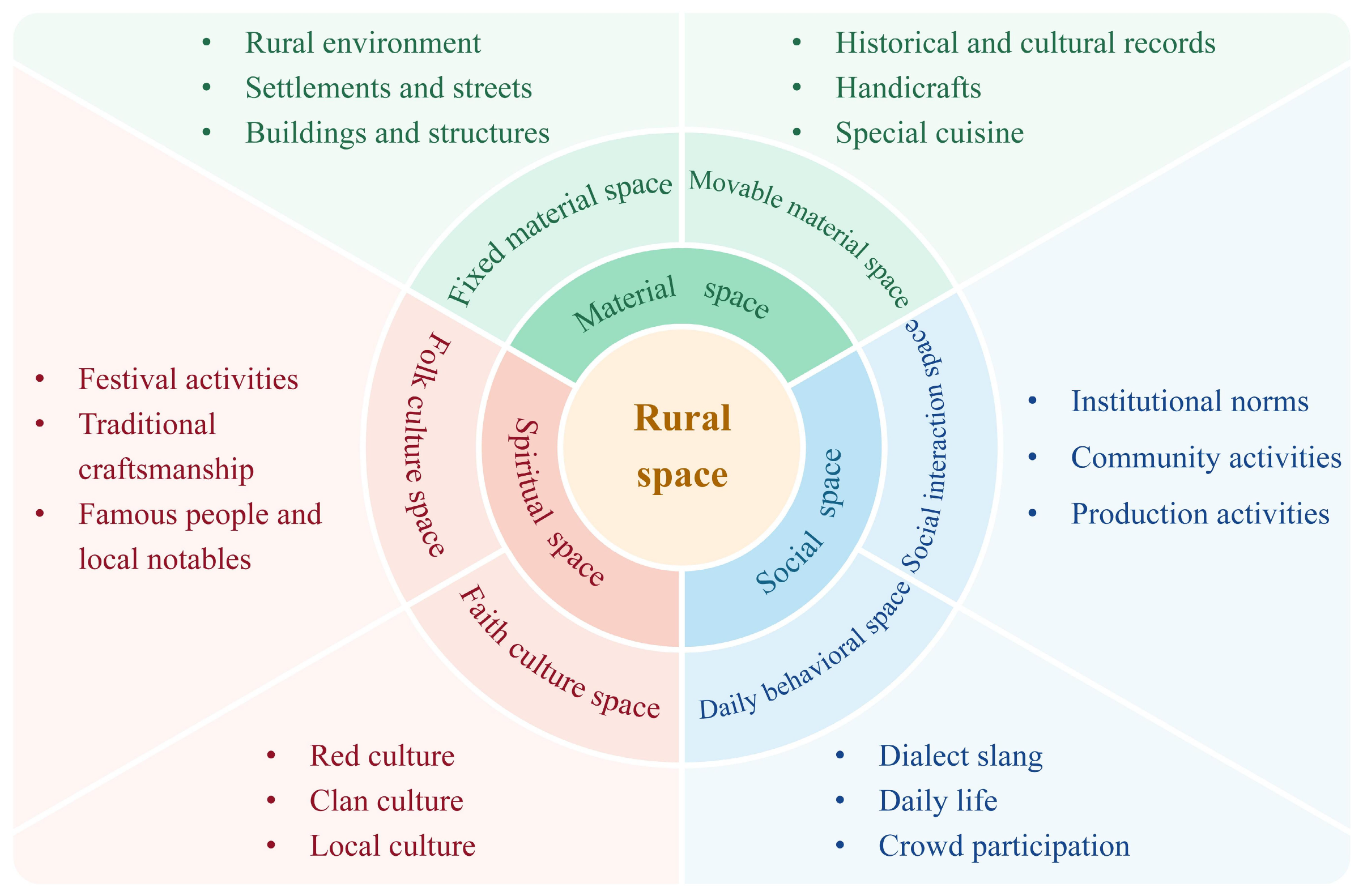
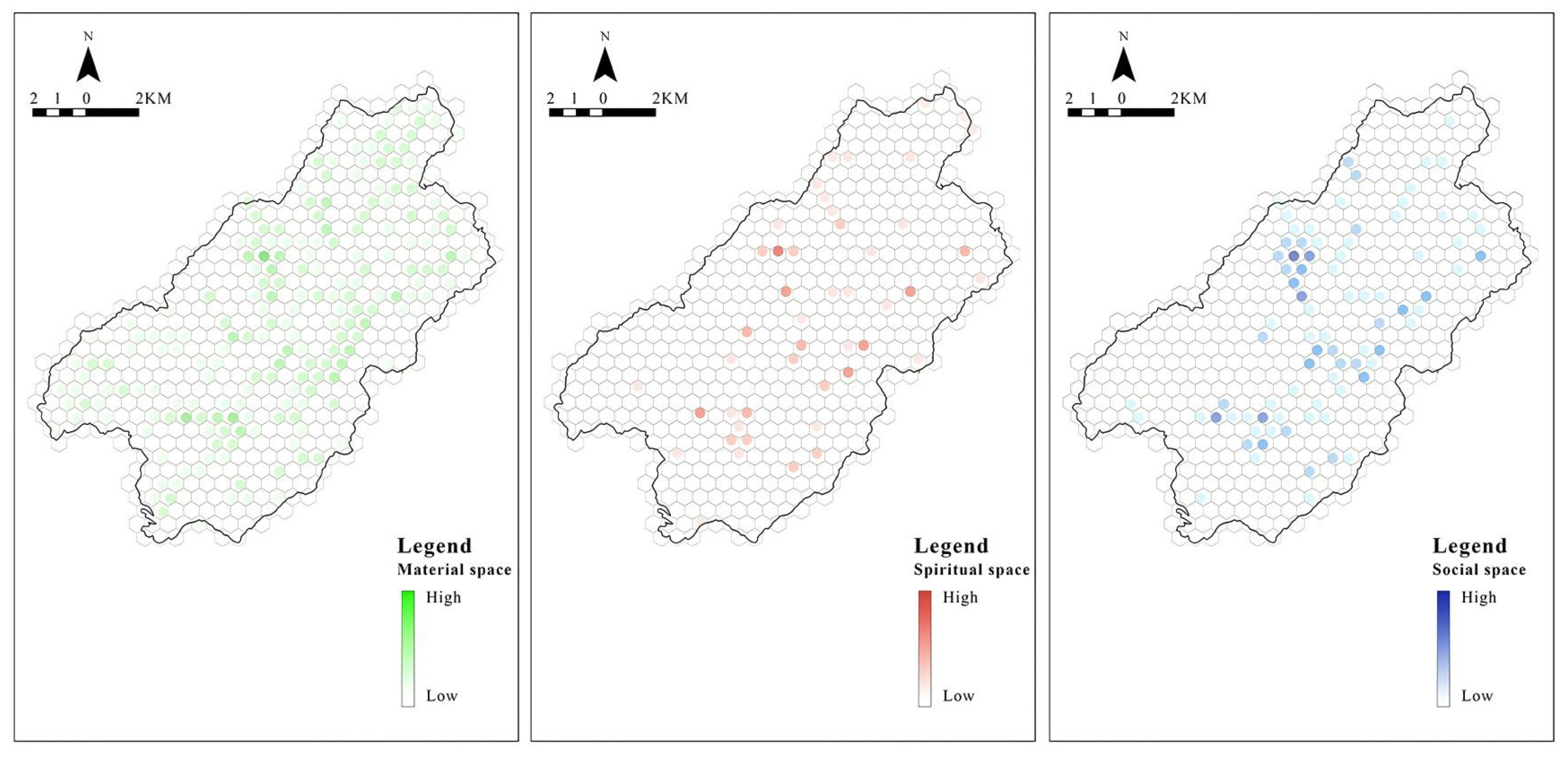
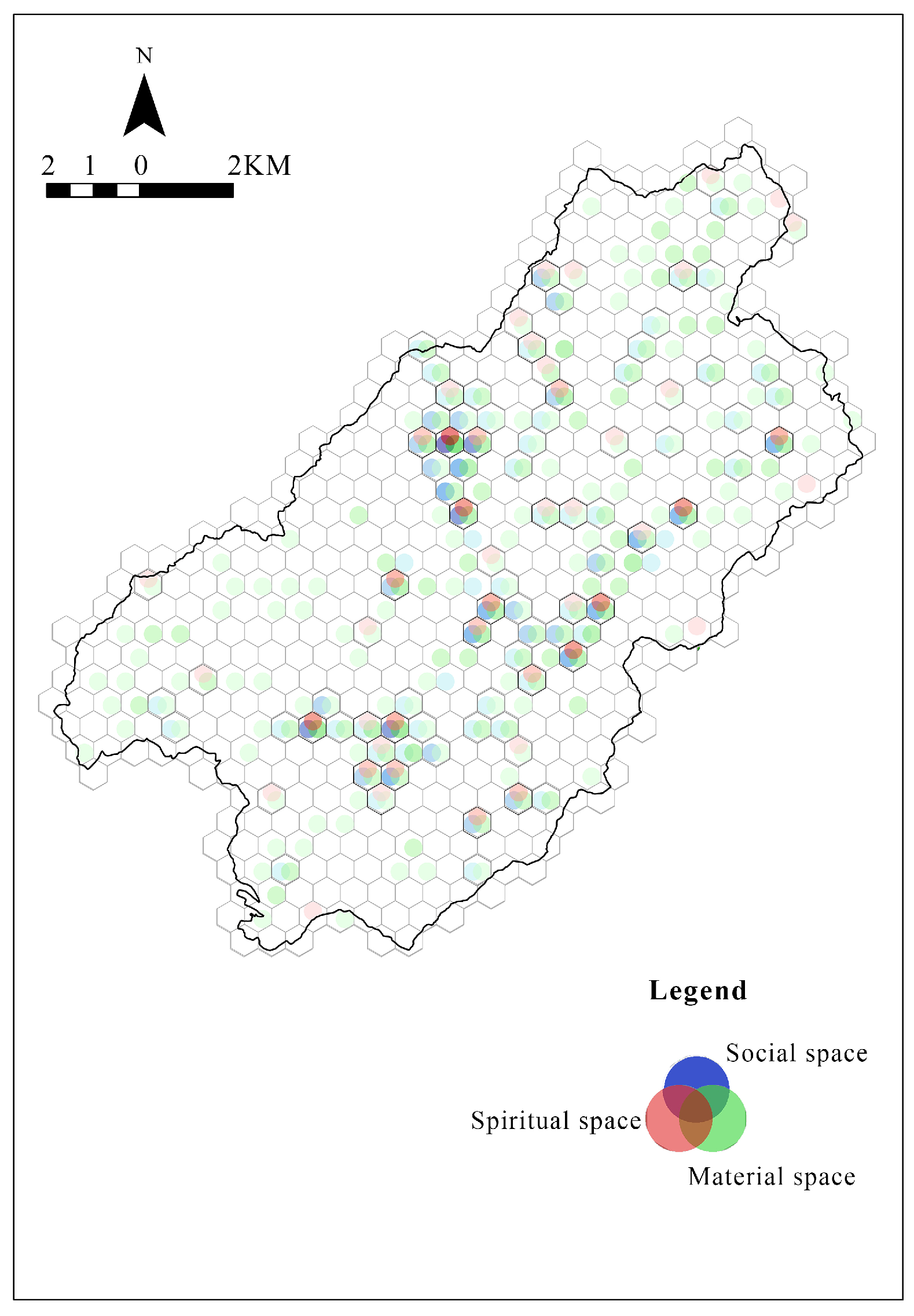
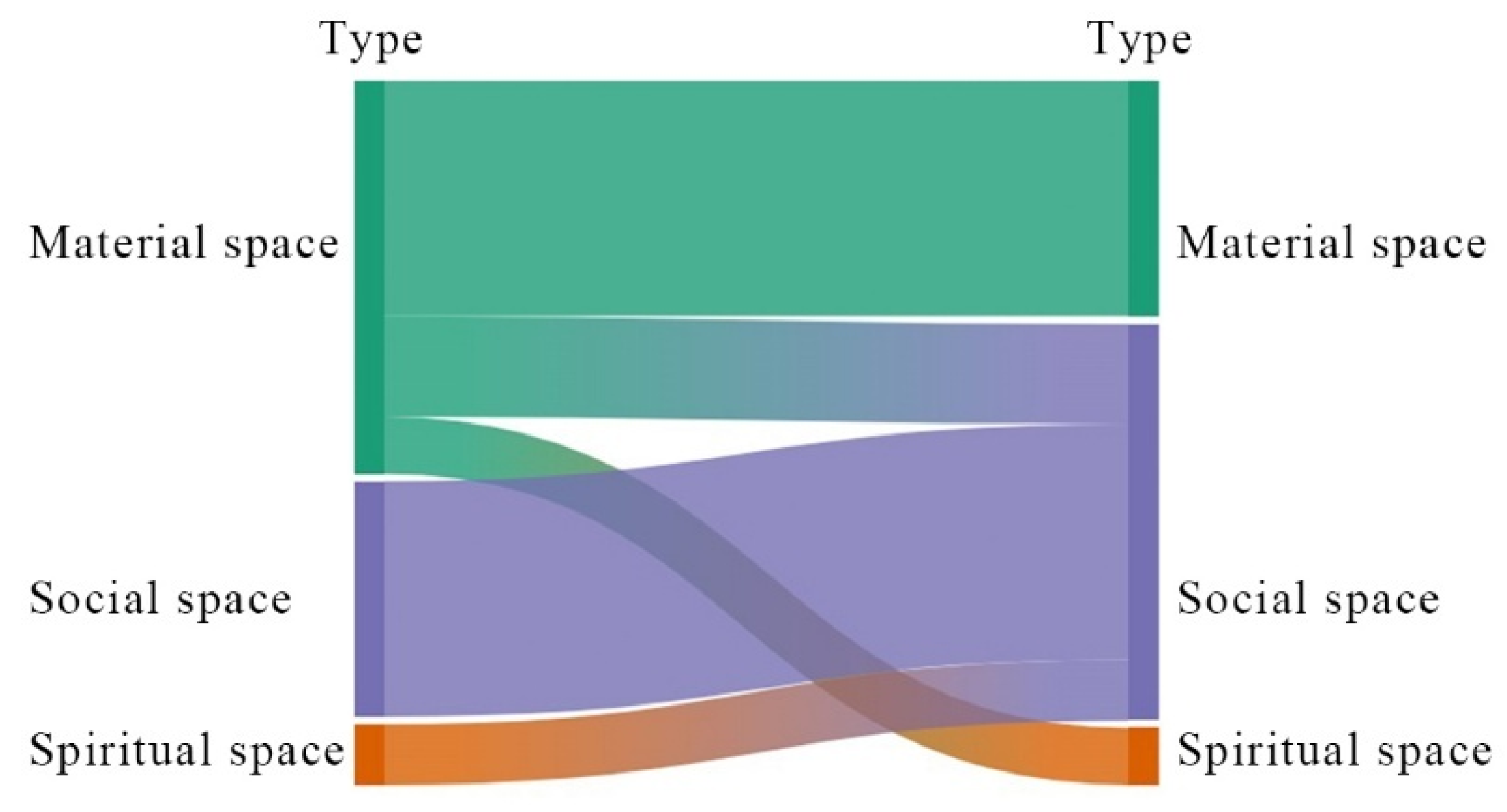
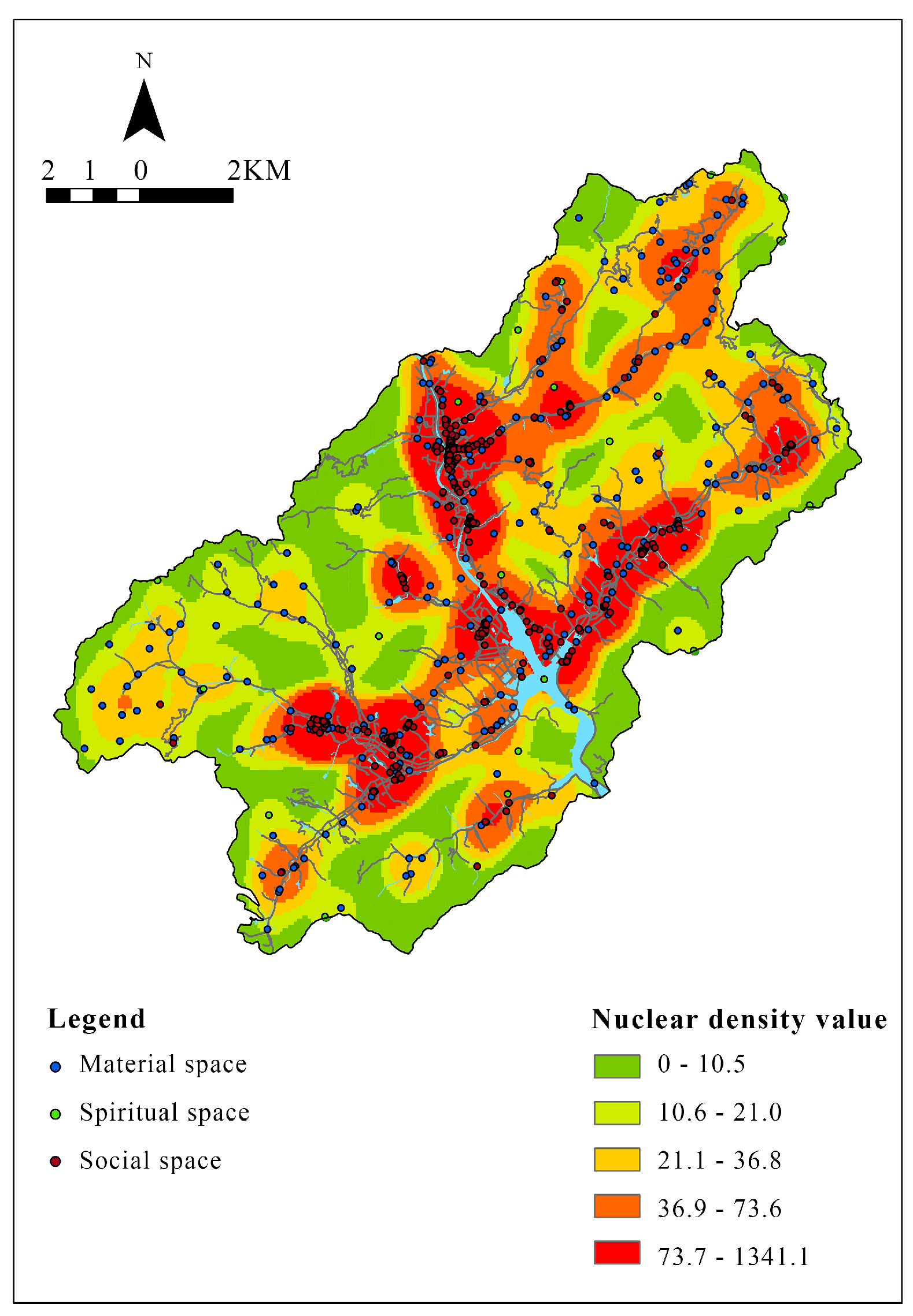

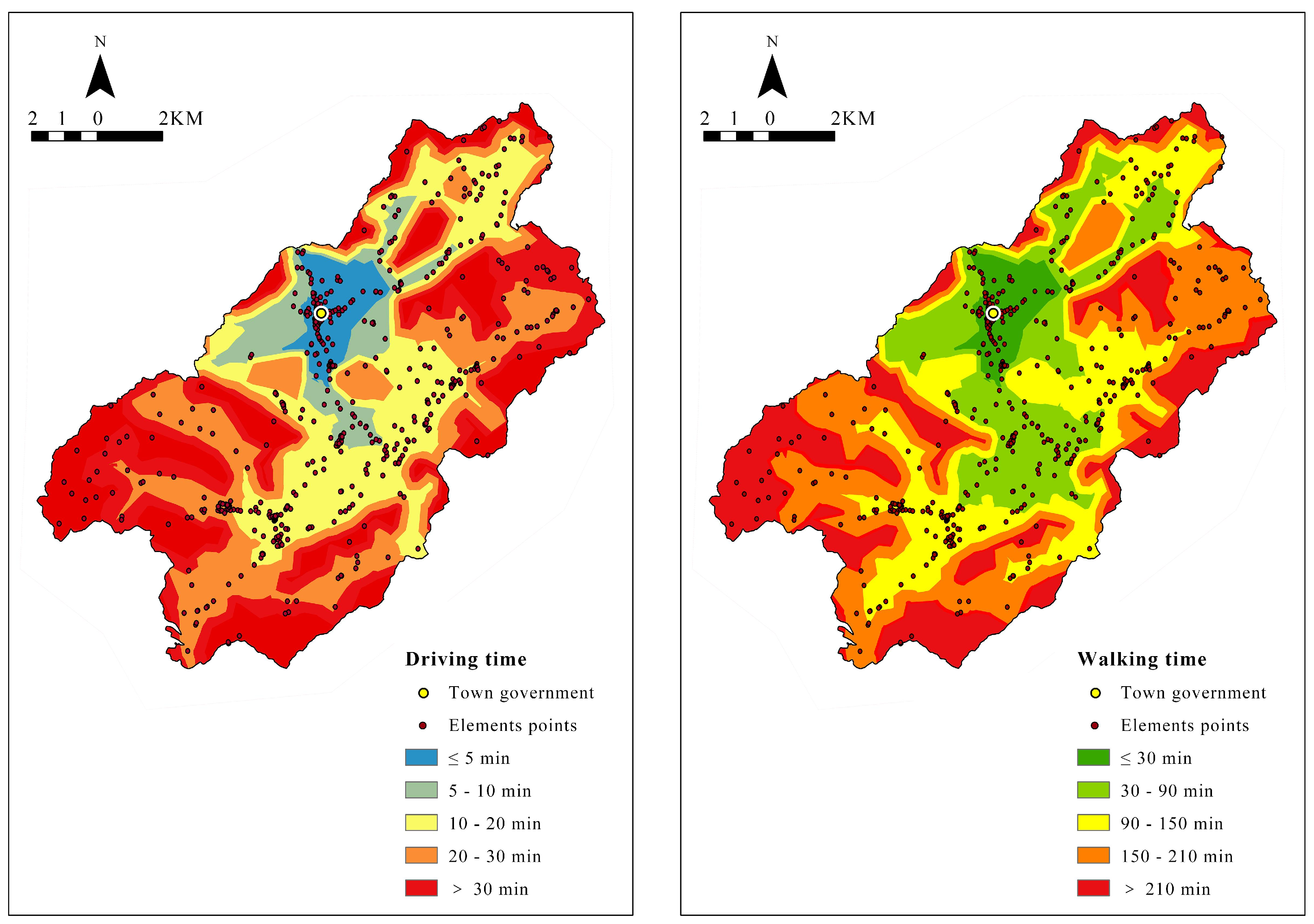
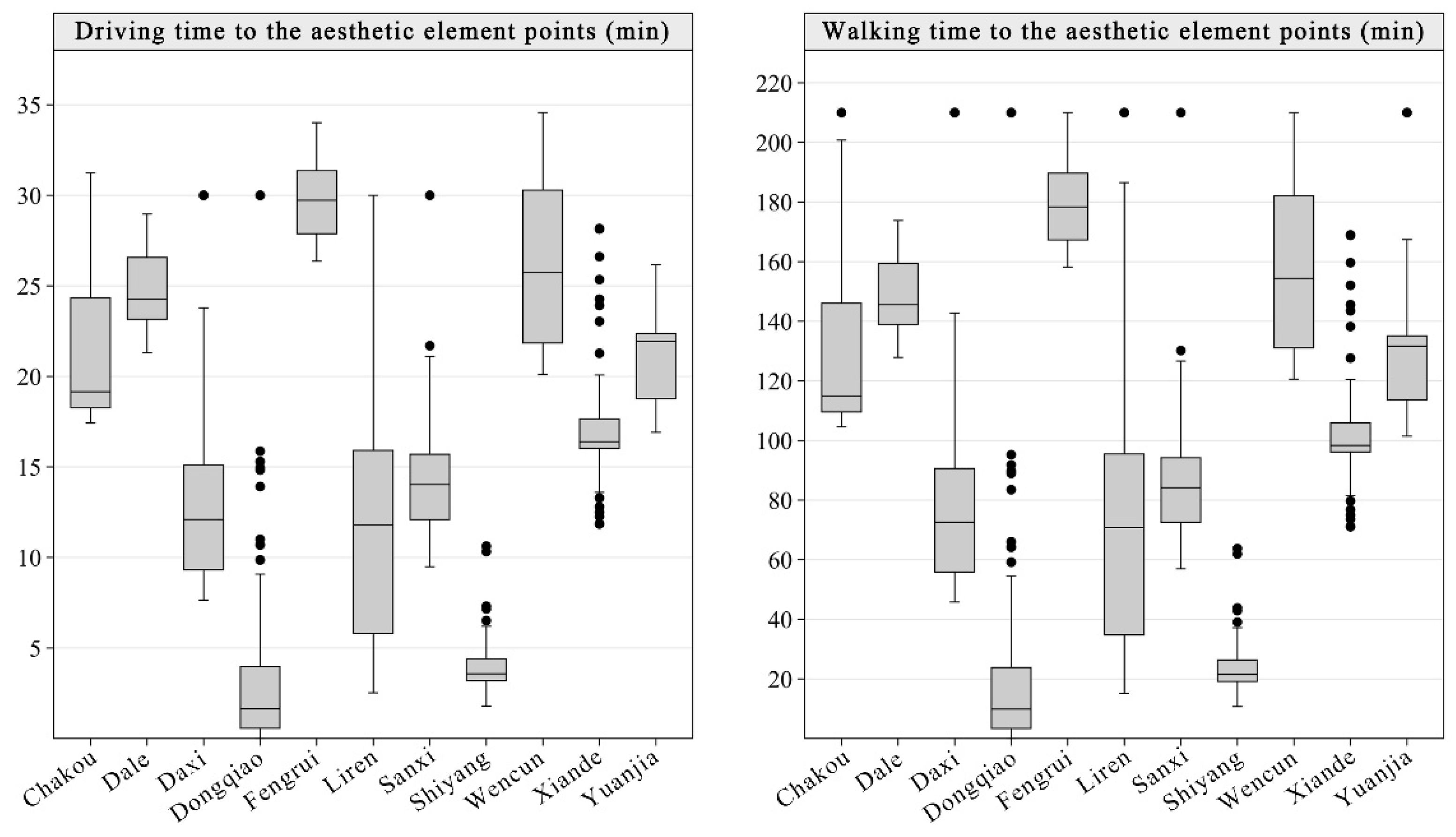

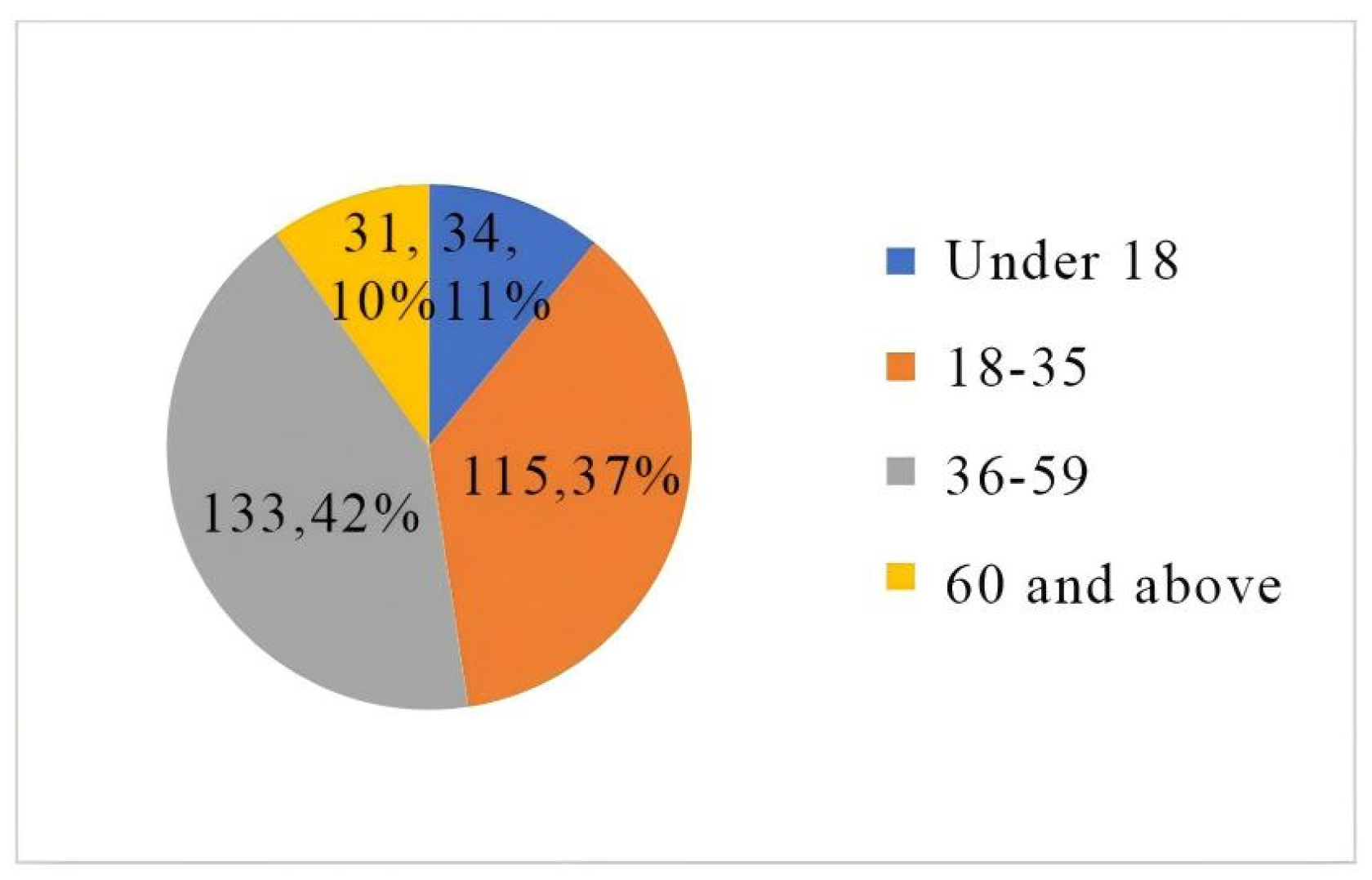
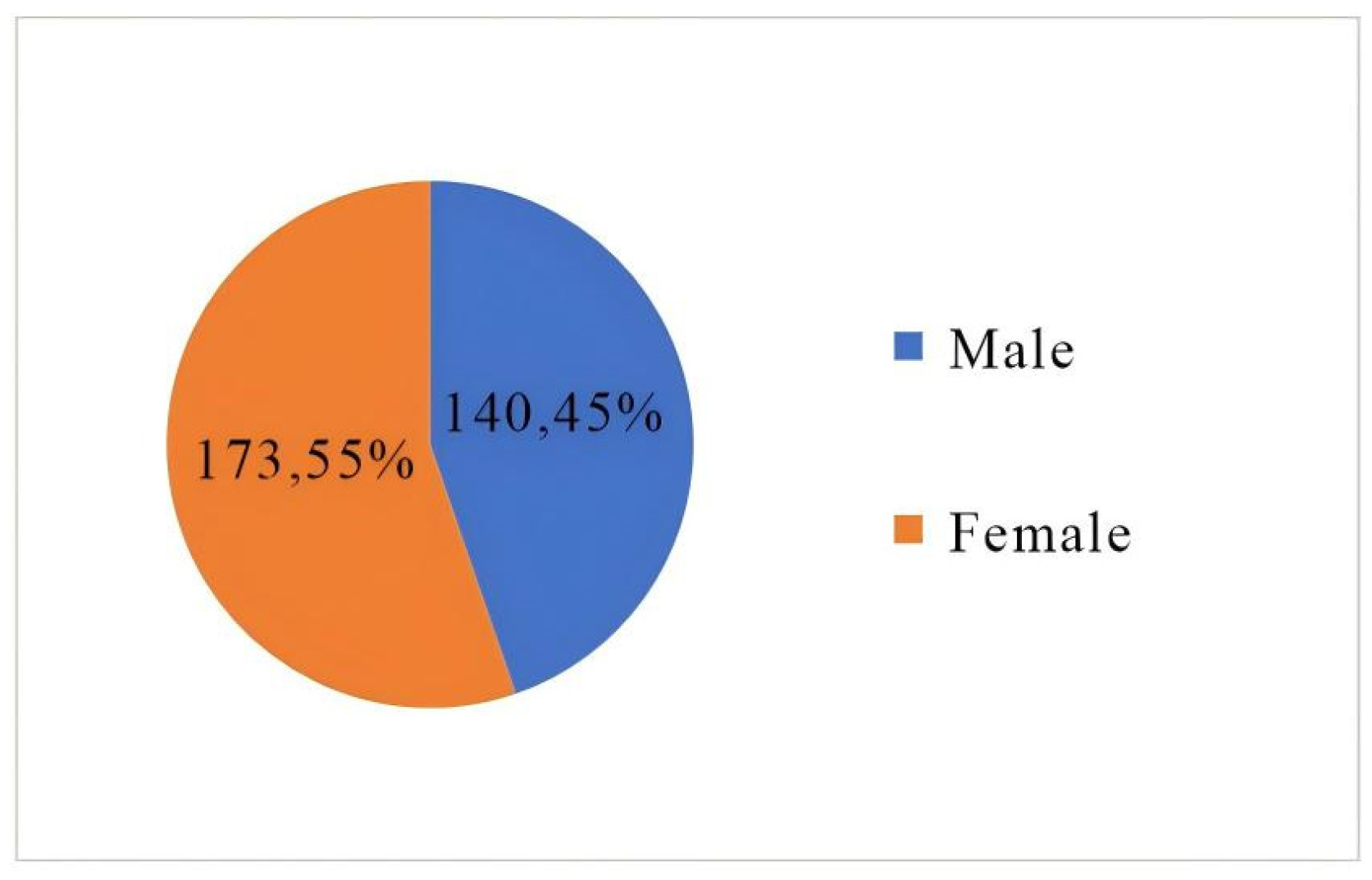
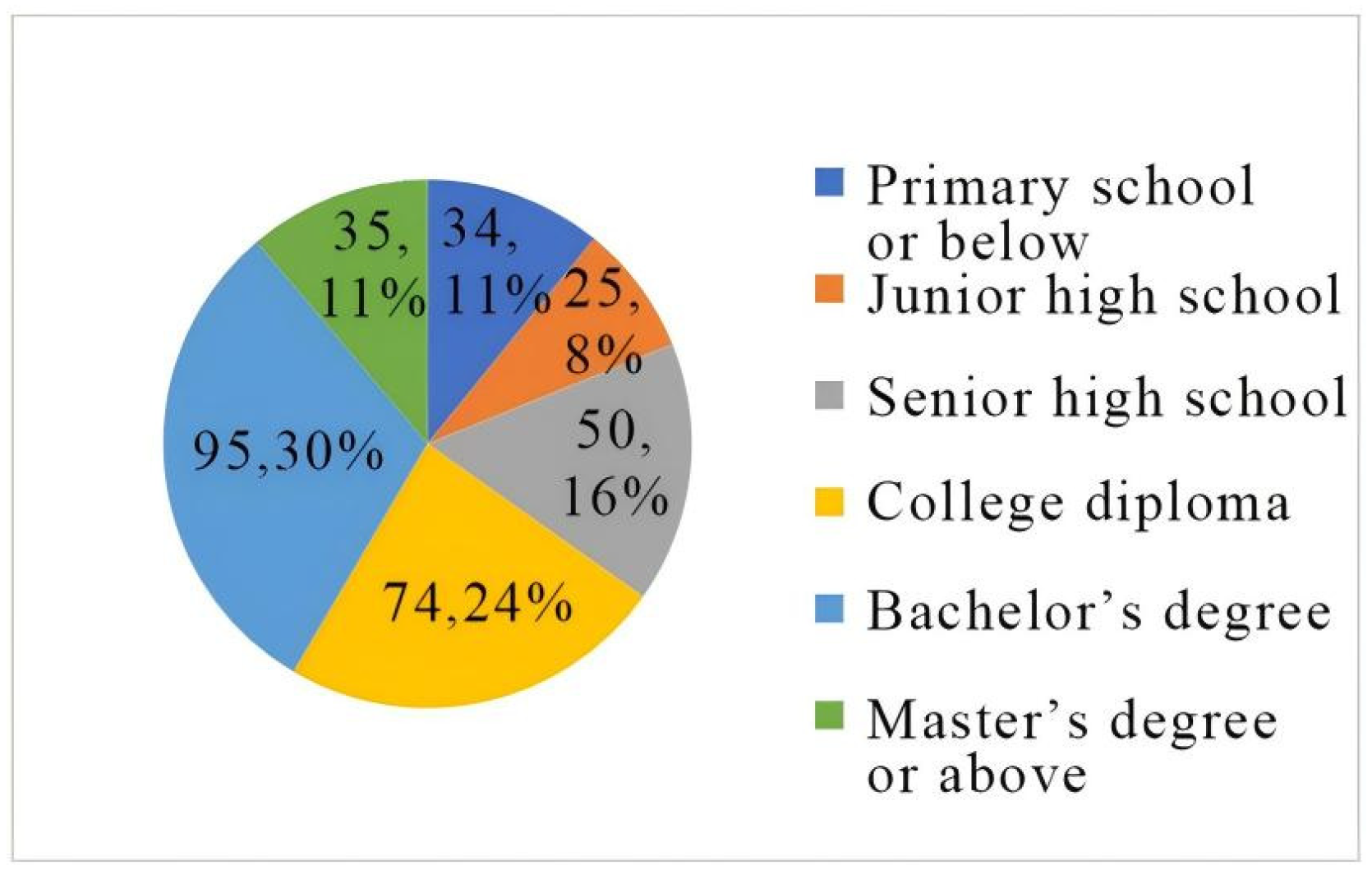
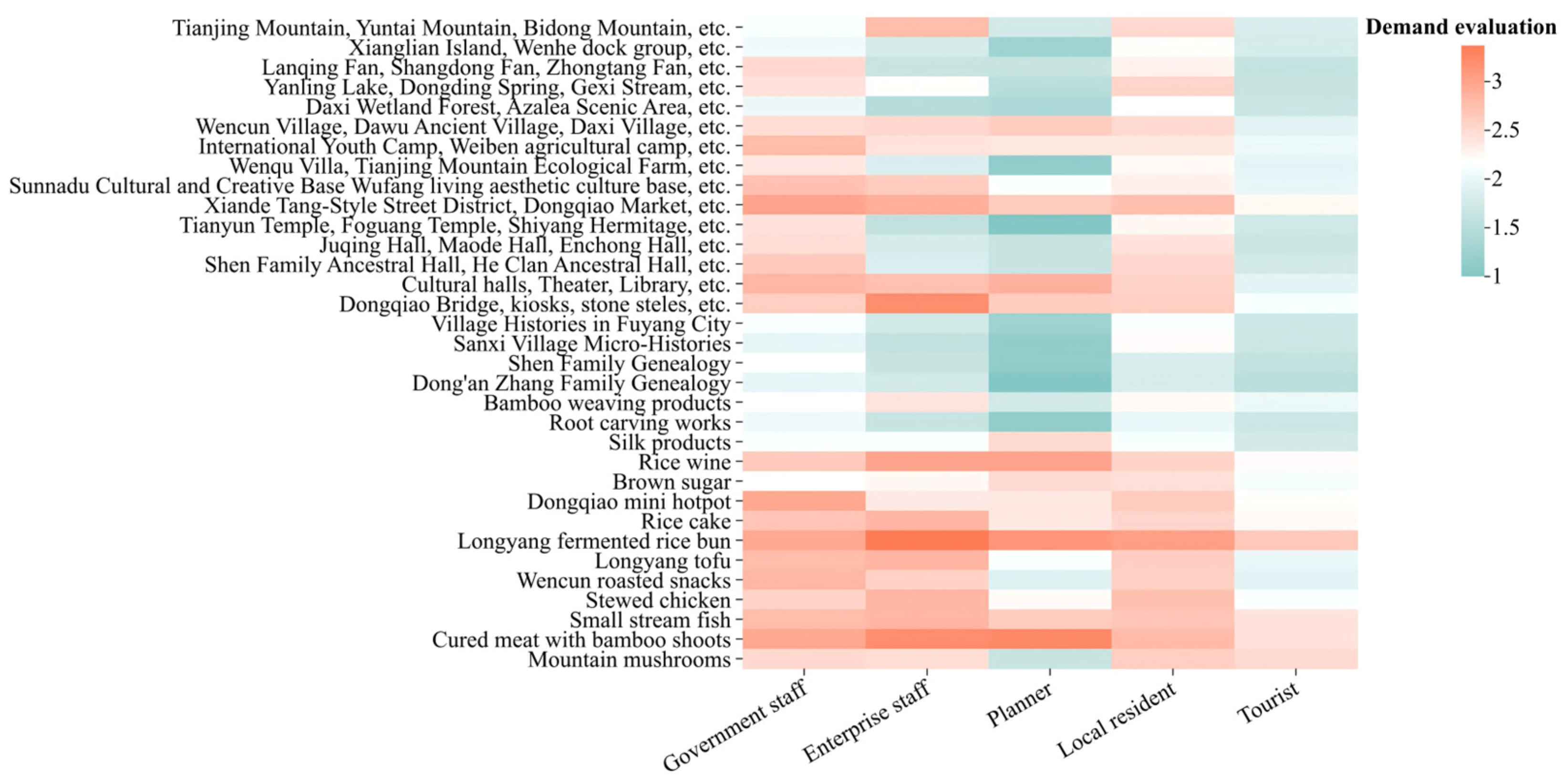





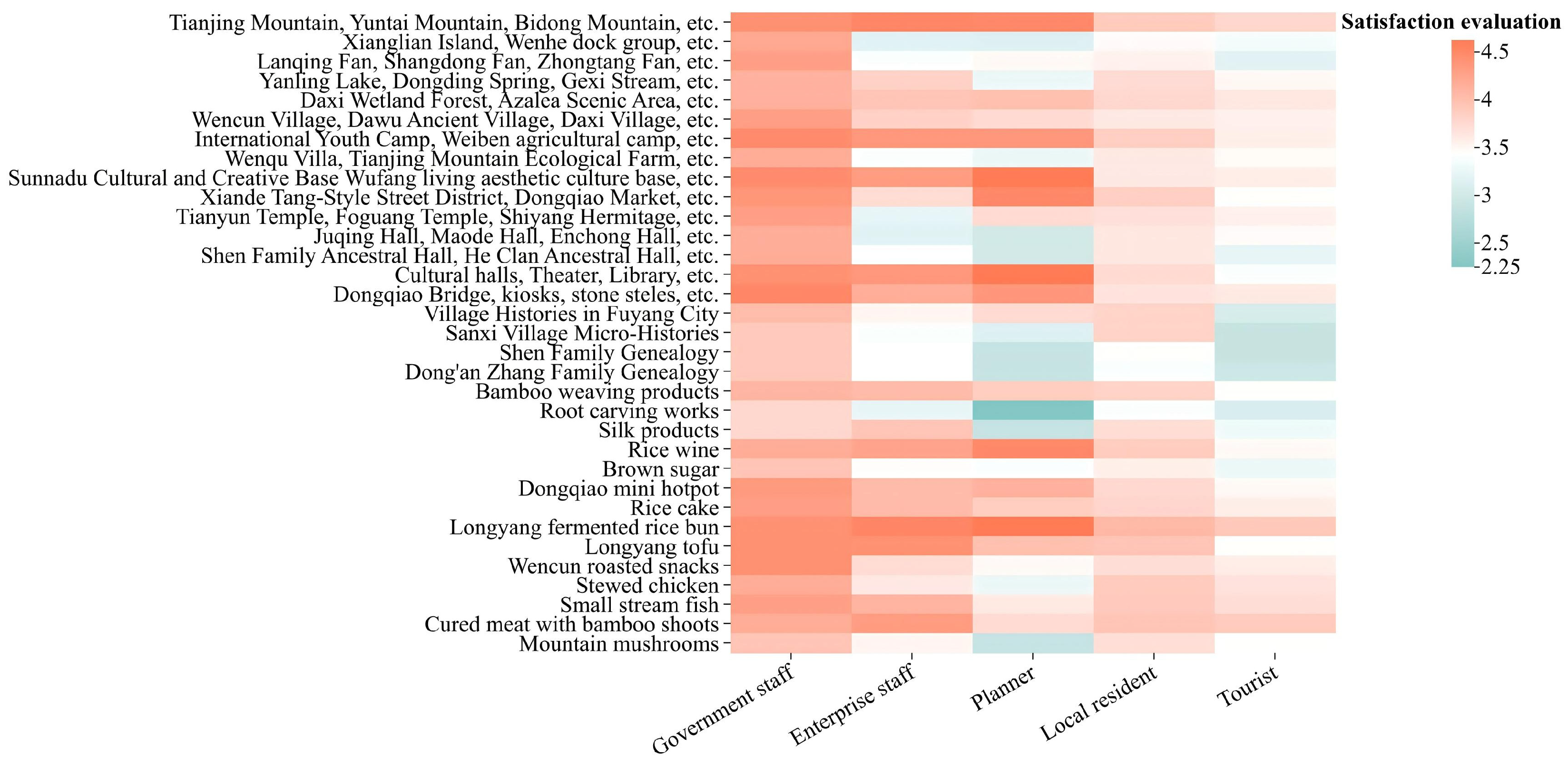
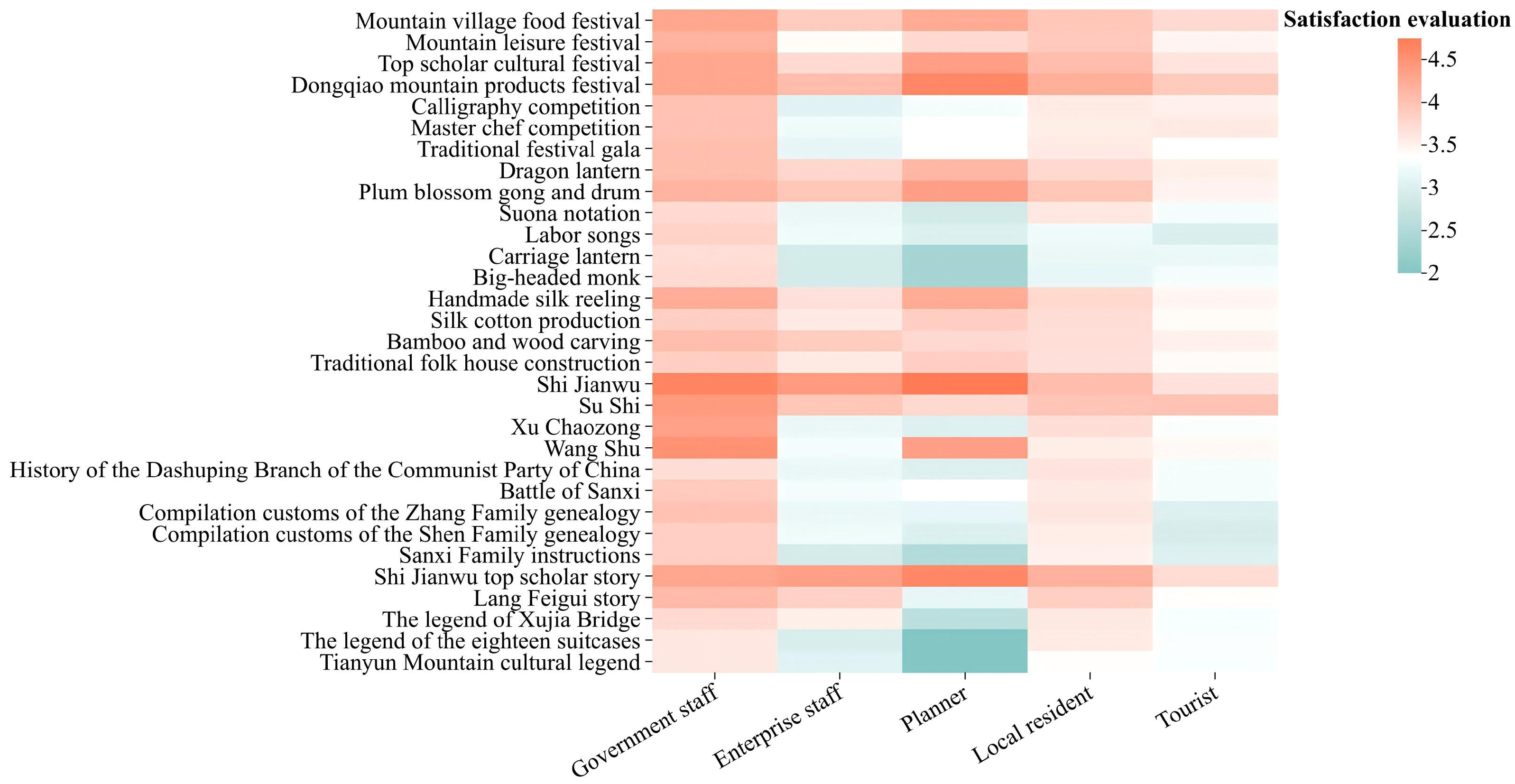

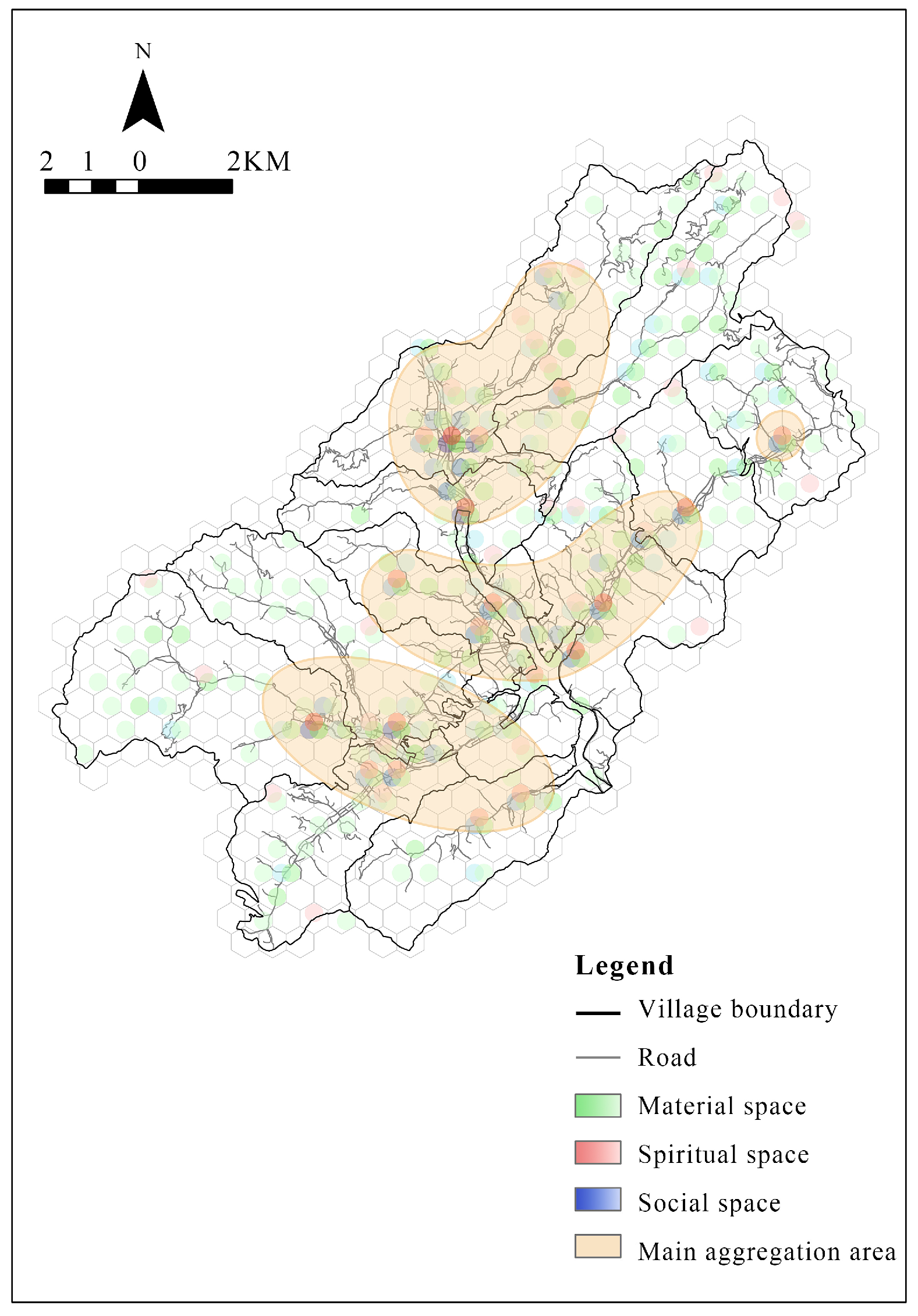

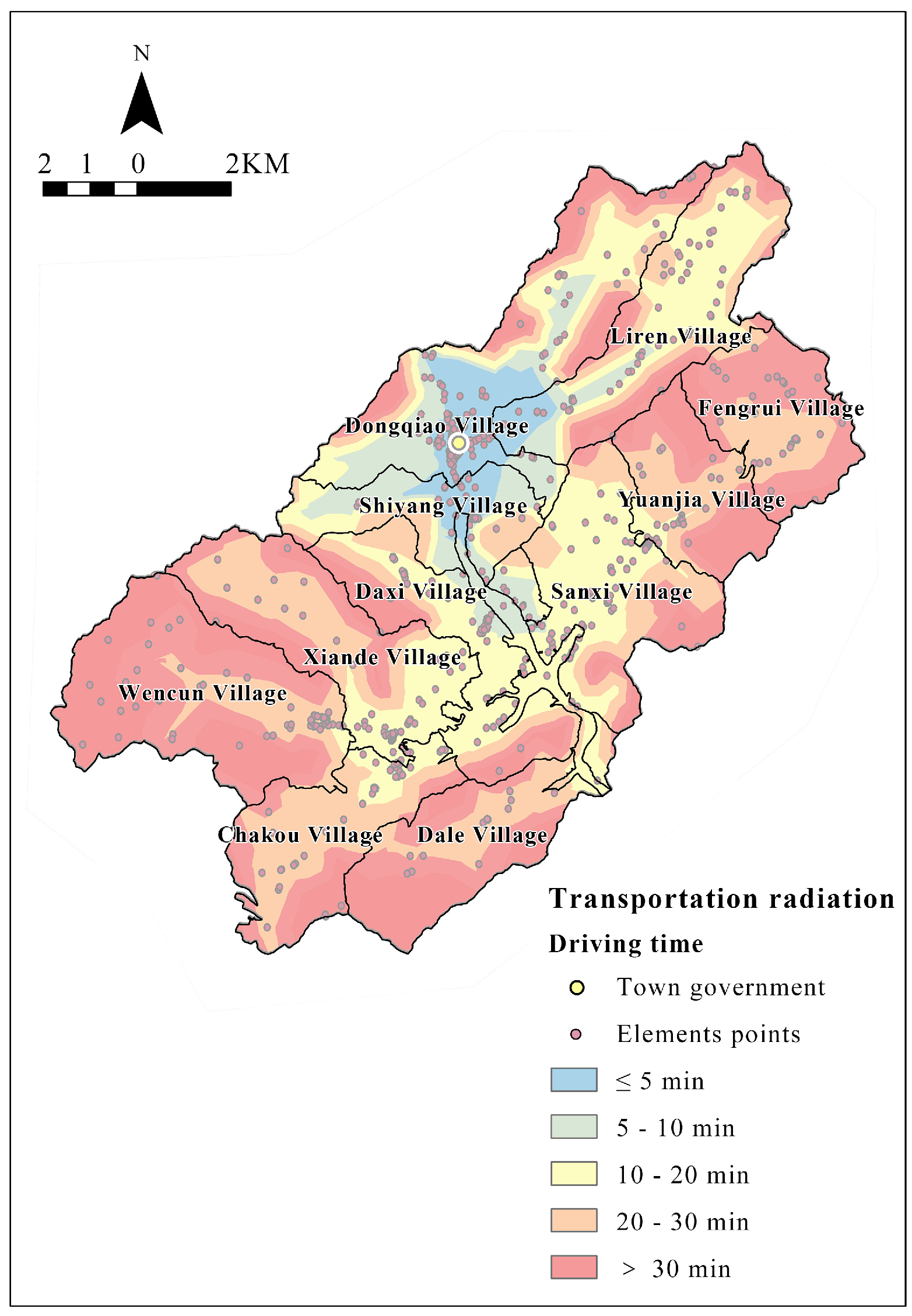
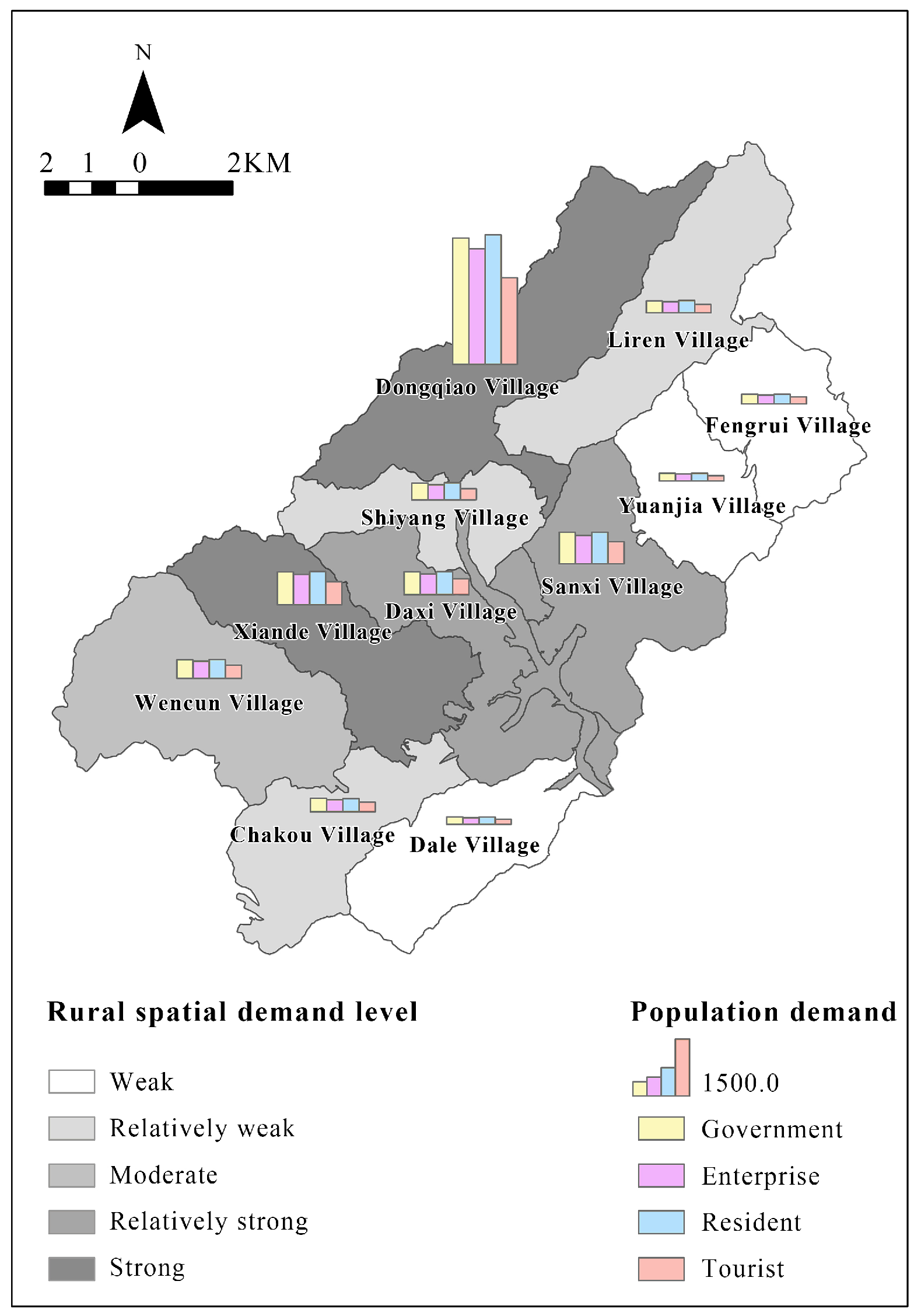
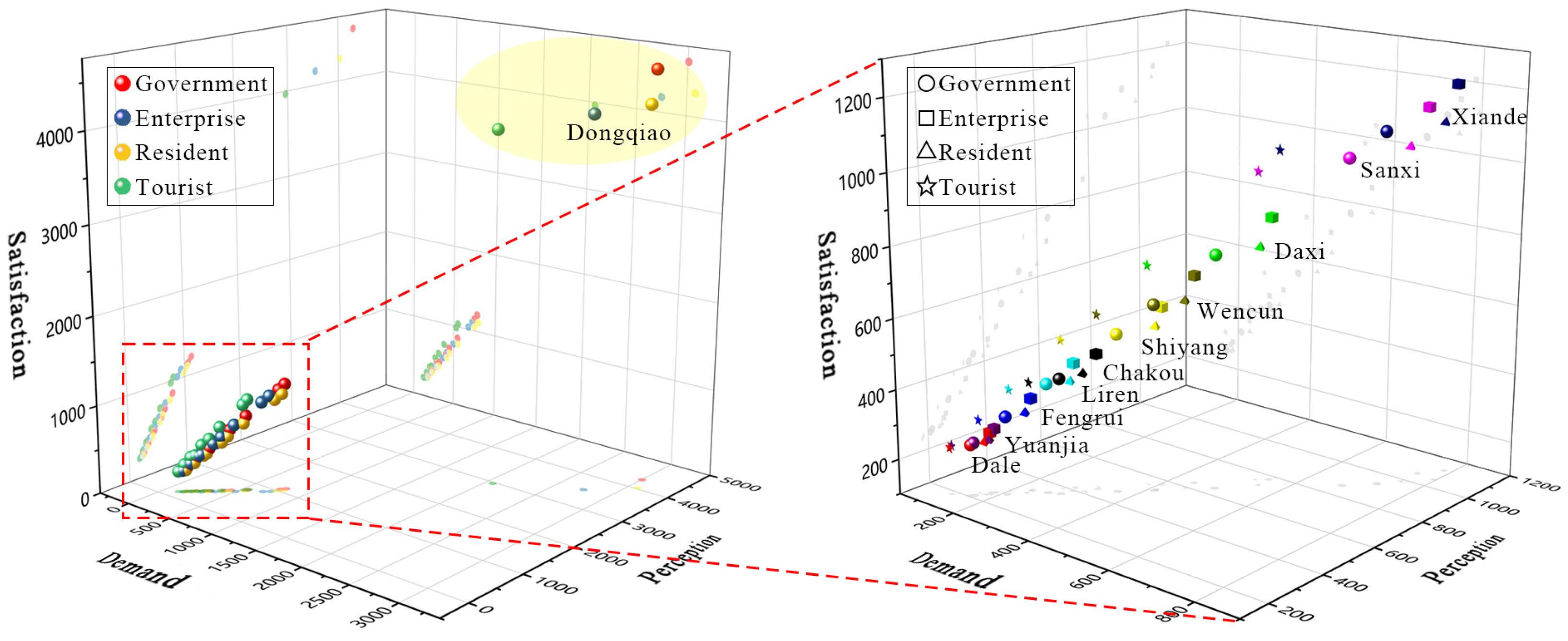
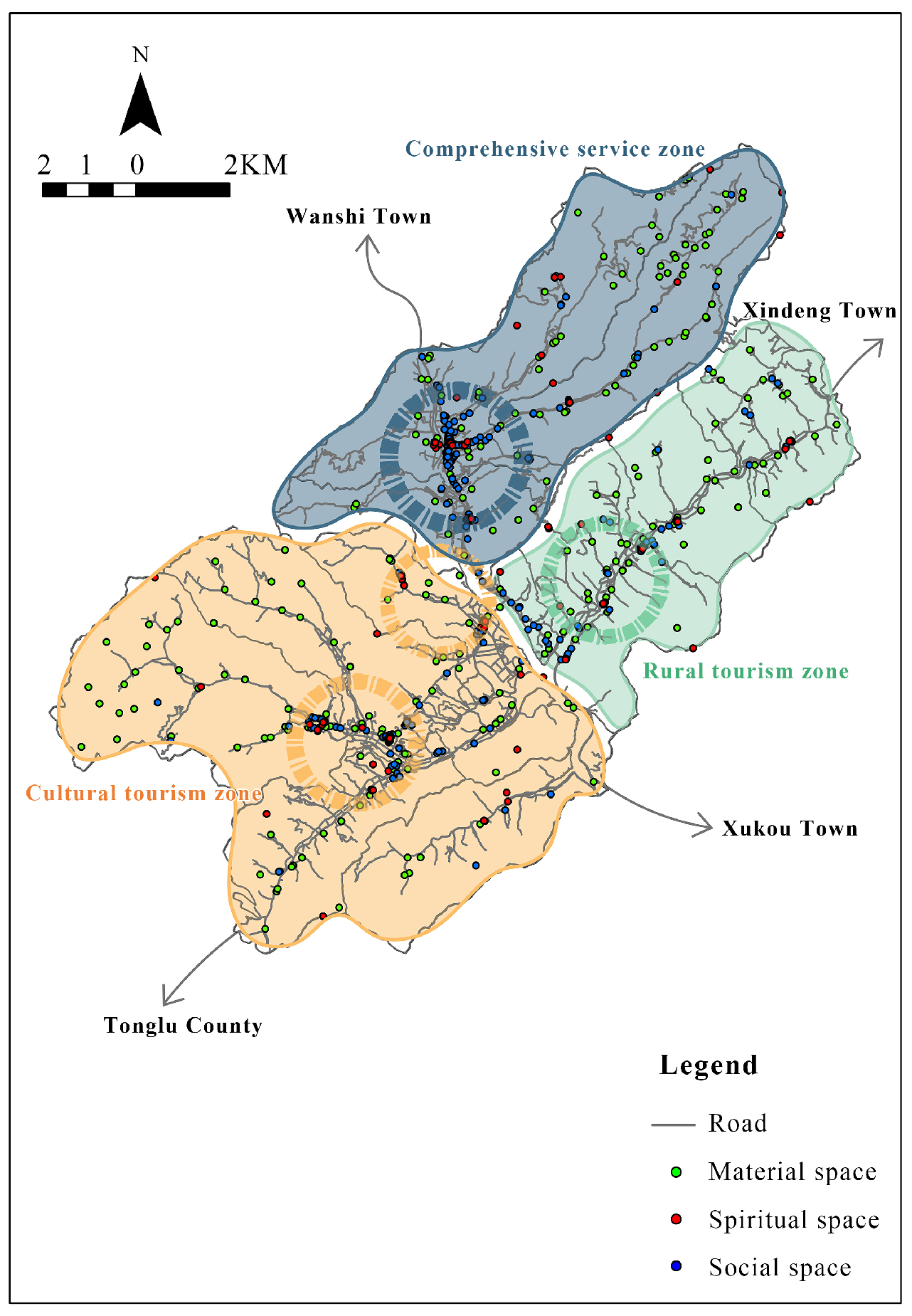
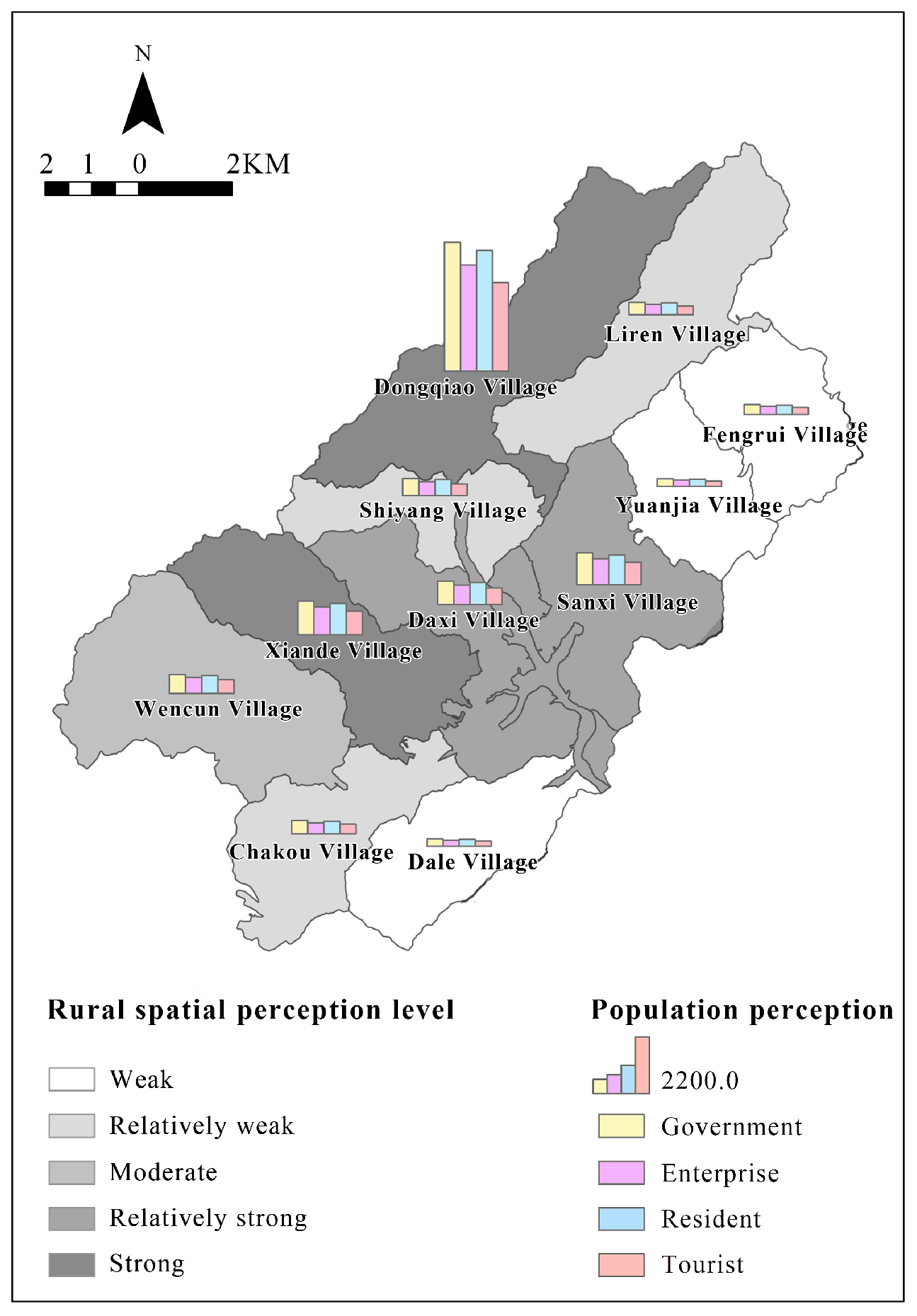

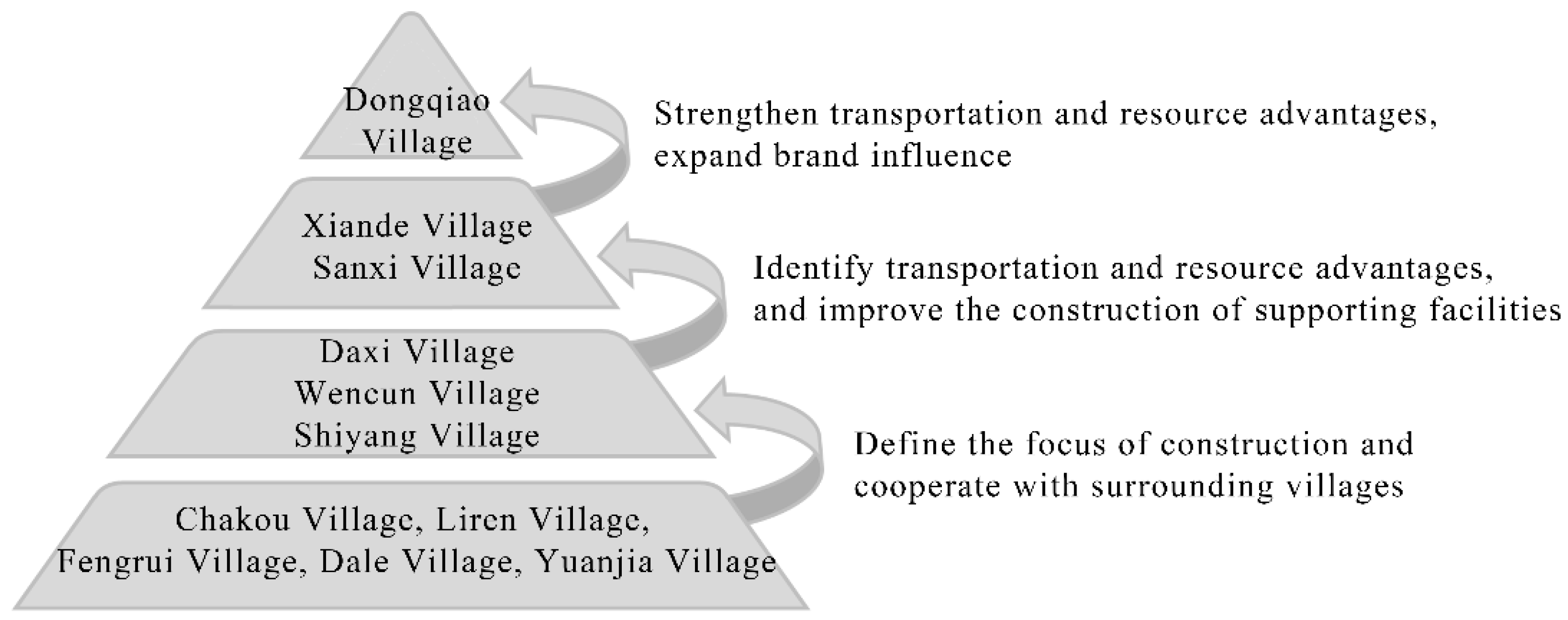
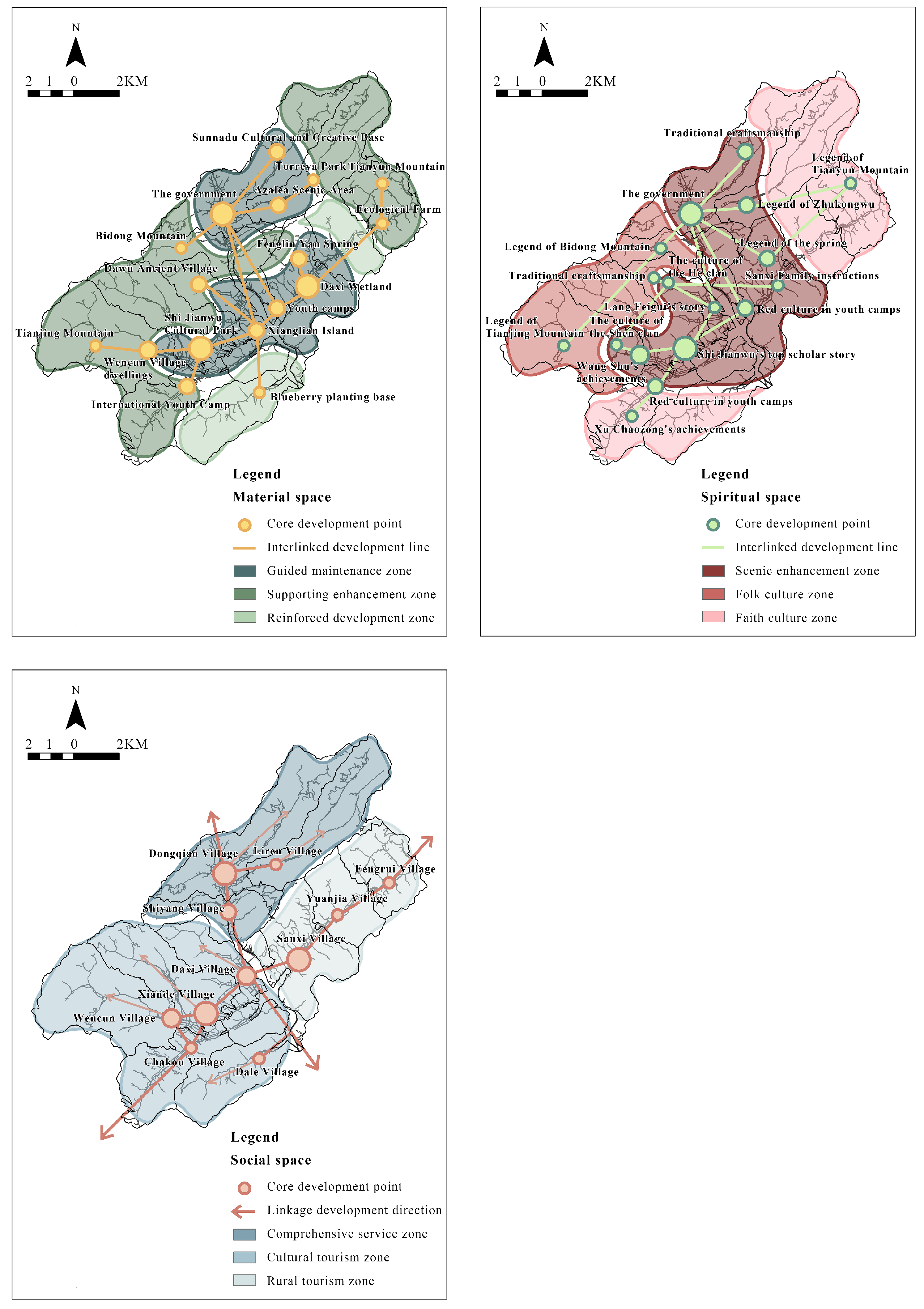
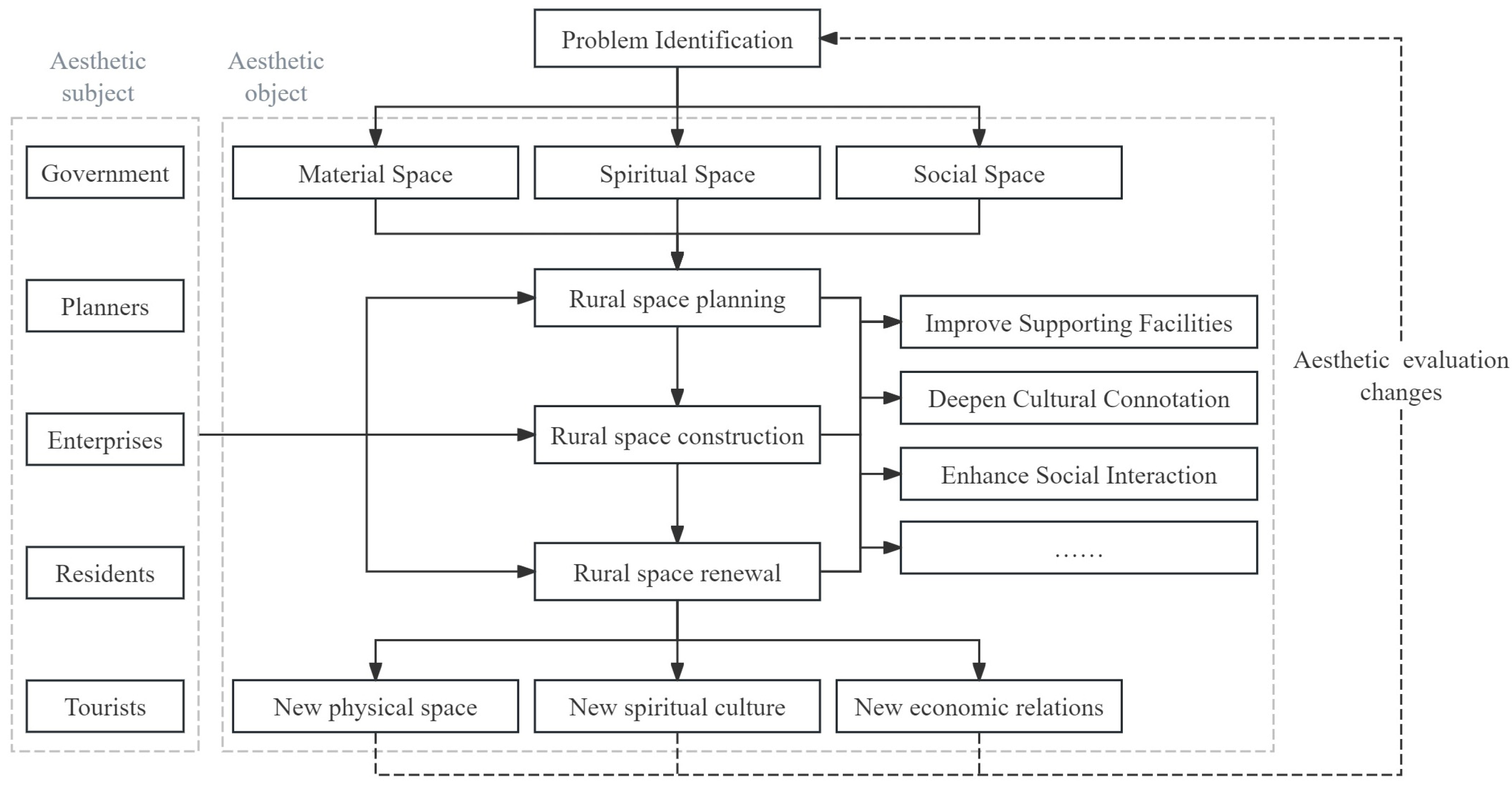
| Dimension | Number of Terms | Sample Size | Cronbach’s α Coefficient |
|---|---|---|---|
| Material space | 99 | 313 | 0.971 |
| Spiritual space | 93 | 313 | 0.987 |
| Social space | 18 | 313 | 0.914 |
| Dimension | KMO Value | Bartlett’s Test of Sphericity | ||
|---|---|---|---|---|
| Approximate Chi-Square | df | p Value | ||
| Material space | 0.862 | 27,001.099 | 4851 | 0.000 |
| Spiritual space | 0.884 | 29,130.900 | 4278 | 0.000 |
| Social space | 0.917 | 3083.817 | 153 | 0.000 |
| Categories | Time/ Minutes | Chakou | Dale | Daxi | Dongqiao | FengRui | Liren | Sanxi | Shiyang | Wencun | Xiande | Yuanjia |
|---|---|---|---|---|---|---|---|---|---|---|---|---|
| Drive | Min | 17 | 21 | 8 | 0 | 26 | 3 | 9 | 2 | 20 | 12 | 17 |
| Max | 31 | 29 | 18 | 16 | 34 | 20 | 22 | 11 | 35 | 28 | 26 | |
| Avg | 21 | 25 | 13 | 3 | 30 | 12 | 14 | 5 | 26 | 17 | 22 | |
| Walk | Min | 105 | 128 | 46 | 0 | 158 | 15 | 57 | 11 | 121 | 71 | 101 |
| Max | 210 | 174 | 210 | 210 | 210 | 210 | 210 | 64 | 210 | 169 | 210 | |
| Avg | 128 | 148 | 80 | 21 | 179 | 73 | 87 | 34 | 158 | 105 | 133 |
| Level | Village | Characteristics |
|---|---|---|
| 1 | Dongqiao, Daxi, Sanxi, Xiande | Aesthetic elements are abundant and clustered, transportation is strongly radiative, and aesthetic demand is strong. |
| 2 | Wencun, Chakou, Fengrui | Aesthetic elements are abundant and clustered, transportation is weakly radiative, and aesthetic demand is weak. |
| 3 | Shiyang, Liren | Aesthetic elements are scarce or dispersed, transportation is strongly radiative, and aesthetic demand is weak. |
| 4 | Yuanjia, Dale | Aesthetic elements are scarce or dispersed, transportation is weakly radiative, and aesthetic demand is weak. |
| Village (Aesthetic Subject) | Characteristics |
|---|---|
| Dongqiao (government, enterprises, residents and tourists), Sanxi (government, enterprises, and residents), Xiande (government, enterprises, and residents), Daxi (government, residents) and Wencun (government, residents) | High demand, high perception, and high satisfaction. |
| Sanxi (tourists), Xiande (tourists), Daxi (enterprises and tourists), Wencun (enterprises and tourists) | Low demand, high perception, and high satisfaction. |
| Shiyang, Chakou, Liren, Fengrui, Yuanjia, Dale (government, enterprises, residents, tourists) | Low demand, low perception, and low satisfaction. |
Disclaimer/Publisher’s Note: The statements, opinions and data contained in all publications are solely those of the individual author(s) and contributor(s) and not of MDPI and/or the editor(s). MDPI and/or the editor(s) disclaim responsibility for any injury to people or property resulting from any ideas, methods, instructions or products referred to in the content. |
© 2025 by the authors. Licensee MDPI, Basel, Switzerland. This article is an open access article distributed under the terms and conditions of the Creative Commons Attribution (CC BY) license (https://creativecommons.org/licenses/by/4.0/).
Share and Cite
Yin, X.; Zhao, H.; Wang, F.; Chang, W.-S.; Dou, L. Aesthetic Evaluation of Rural Space and Optimisation of Planning Strategies: A Case Study of Dongqiao Town, Zhejiang Province. Buildings 2025, 15, 4140. https://doi.org/10.3390/buildings15224140
Yin X, Zhao H, Wang F, Chang W-S, Dou L. Aesthetic Evaluation of Rural Space and Optimisation of Planning Strategies: A Case Study of Dongqiao Town, Zhejiang Province. Buildings. 2025; 15(22):4140. https://doi.org/10.3390/buildings15224140
Chicago/Turabian StyleYin, Xunzhi, Haolin Zhao, Fan Wang, Wen-Shao Chang, and Lijun Dou. 2025. "Aesthetic Evaluation of Rural Space and Optimisation of Planning Strategies: A Case Study of Dongqiao Town, Zhejiang Province" Buildings 15, no. 22: 4140. https://doi.org/10.3390/buildings15224140
APA StyleYin, X., Zhao, H., Wang, F., Chang, W.-S., & Dou, L. (2025). Aesthetic Evaluation of Rural Space and Optimisation of Planning Strategies: A Case Study of Dongqiao Town, Zhejiang Province. Buildings, 15(22), 4140. https://doi.org/10.3390/buildings15224140






